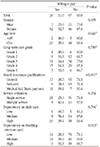Abstract
Objectives
This study was conducted to identify the demand and willingness to pay for oral hygiene services among elderly people with long-term care insurance.
Methods
Our study was a cross-sectional analysis. Subjects comprised 126 elderly individuals from long-term home-care centers. A total of 28 centers were selected through convenience sampling from among 78 centers in ○○. For analysis, semi-structured questionnaires that required about 20–30 minutes to complete were used. Analysis was performed using SPSS 23.0 software.
Results
The overall demand for oral hygiene services was 44.4%, and willingness to pay was 31.0%. Thirty-three people (58.9%) of elderly those who have demand for an oral hygiene service were willing to pay for the service, and 64 people (91.4%) who did not have a demand were not willing to pay for it. Among those with partial dependence on brushing, 65.6% had demand for oral hygiene services and 50.0% were willing to pay costs. Among basic livelihood beneficiaries, 69.6% were willing to pay for oral hygiene services; general subjects and relievers were less willing to pay.
Figures and Tables
Table 2
General characteristics of the subjects and diferences in demand for oral hygiene service Unit: N(%)

References
1. Korea laws. Act on Long-term care insurance for older person [Internet]. cited 2018 Aug 23. Available from: http://www.law.go.kr/lsInfoP.do?lsiSeq=202643&efYd=20180614#0000.
2. National health insurance service. 2016 Long term care insurance statistical yearbook. Seoul: National health insurance service;2017. p. 683.
3. Ministry of health and welfare. 2017 Survey of the elderly. Seoul: Ministry of Health and Welfare;2017. p. 885.
4. Genco RJ. Current view of risk factors for periodontal diseases. J Periodontol. 1996; 67:1041–1049.

5. El-Solh AA, Pietrantoni C, Bhat A, Aquilina AT, Okada M, Grover V, et al. Microbiology of severe aspiration pneumonia in institutionalized elderly. Am J Respir Crit Care Med. 2003; 167:1650–1654.

6. Kim JE, Lee IS. The effects of visiting nursing services in Long-term care insurance: A difference-in-difference analysis. J Korean Acad Community Health Nurs. 2015; 26:89–99.

7. Lee S, Kwak C. Effects of visiting nursing services in Long-term care insurance on utilization of health care. J Korean Acad Community Health Nurs. 2016; 27:272–283.

8. Lee HY, Moon YP. The effect of long-term care utilization on the care utilization of the elderly. Korean J Health Econ Policy. 2015; 21:81–102.
9. Byeon DH, Jin HH. Importance and performances of visiting nurse services provided under the long term care insurance system for the elderly. J Korean Acad Community Health Nurs. 2013; 24:332–345.

10. Lee JW, Seomun JH. A study on problems and improvement of home-help services of Long-term care insurance. J Korean Gerontol Soc. 2009; 29:149–175.
11. Lim JY, Kim EJ, Choi KW, Lee JS, Noh WJ. Analysis of barriers and activating factors of visiting nursing in Long-term care insurance. J Korea Contents Assoc. 2012; 12:283–299.

12. Yoon HS. Factors affecting family caregivers' preference and need for community care services. J Korean Gerontol Soc. 2001; 21:141–161.
13. Ahn KS, Ji MG, Min HH. A study on dental professionals' recognition on a system of Long-term care insurance for the elderly. J Korean Acad Dent Hyg Educ. 2009; 9:1–12.
14. Kim HN, Kim GY, Noh HJ, Kim NH. In-depth interview with the Long-term home care center managers for activating home visit oral hygiene service in Long-term care insurance. J Korean Soc Dent Hyg. 2018; 07. 18. [in press].
15. Kim CS, Paik DI, Kim HD, Jin BH, Bae KH. The oral health care needs among elderly people with daily activity problems in Yongin city. J Korean Acad Dent Health. 2007; 31:559–567.
16. Bradshaw J. The concept of social need. New Soc. 1972; 19:640–643.
17. Thompson MS. Willingness to pay and accept risk to cure chronic disease. Am J Public Health. 1986; 76:392–396.

18. Seok JE, Yi GJ. Analysis on the staying at-home of the qualified recipients of Long-term care for aging in place. Health Soc Welf Rev. 2017; 37:5–42.

19. Ahn ES, Hwang JM, Shin MS. Dental utilization associated factors among elderly. J Dent Hyg Sci. 2015; 15:60–66.

20. Lee TJ, Lee SH. Estimation of willingness to pay for Long-term care insurance using the contingent valuation method. Korean J Health Policy Adm. 2006; 16:95–116.

21. Kwak C. Regional comparison of home visiting care service satisfaction among elder beneficiaries of the Long term care insurance. J Korean Acad Community Health Nurs. 2016; 27:114–123.

22. Kim KB, Lee HK, Sok SR. Activities of daily living and nursing needs of the elderly in nursing home. J Korean Acad Community Health Nurs. 2009; 20:1–11.
23. Lee MK, Kim EK. Relationship between resource utilization and Long-term care classification level for Residents in nursing homes. J Korean Acad Nurs. 2010; 40:903–912.

24. Kang SB, Kim HS. The relationship between home-visit nursing services and health care utilization among nursing service recommended beneficiaries of the public Long-term care insurance. Health Policy Manag. 2014; 24:283–290.

25. Son DS. Study on the influence factors of geriatric social work competency of social workers in seniors welfare center. Korean J Gerontol Soc Welf. 2016; 71:195–218.

26. Lee KY, Cho YS, Lim SR. Oral health-related quality of life of the elderly under visiting health care. J Dent Hyg Sci. 2015; 15:325–332.

27. OECD. Pensions at a Glance 2013. OECD and G20 Indicators. Europe: OECD;2013. p. 364.
28. Song DY. Factors affecting family caregivers' preference for utilization of community eldercare services. Korean J Soc Welf. 2003; 53:105–128.
29. Young HM, McCormick WM, Vitaliano P. Attitudes toward cornmunity-based serevices among Japanese american families. Gerontologist. 2002; 42:814–825.

30. Seo DM. Financial structure and prospects of the Long-term care insurance for the elderly in Korea. Korean J Health Econ Policy. 2008; 14:27–56.




 PDF
PDF ePub
ePub Citation
Citation Print
Print





 XML Download
XML Download